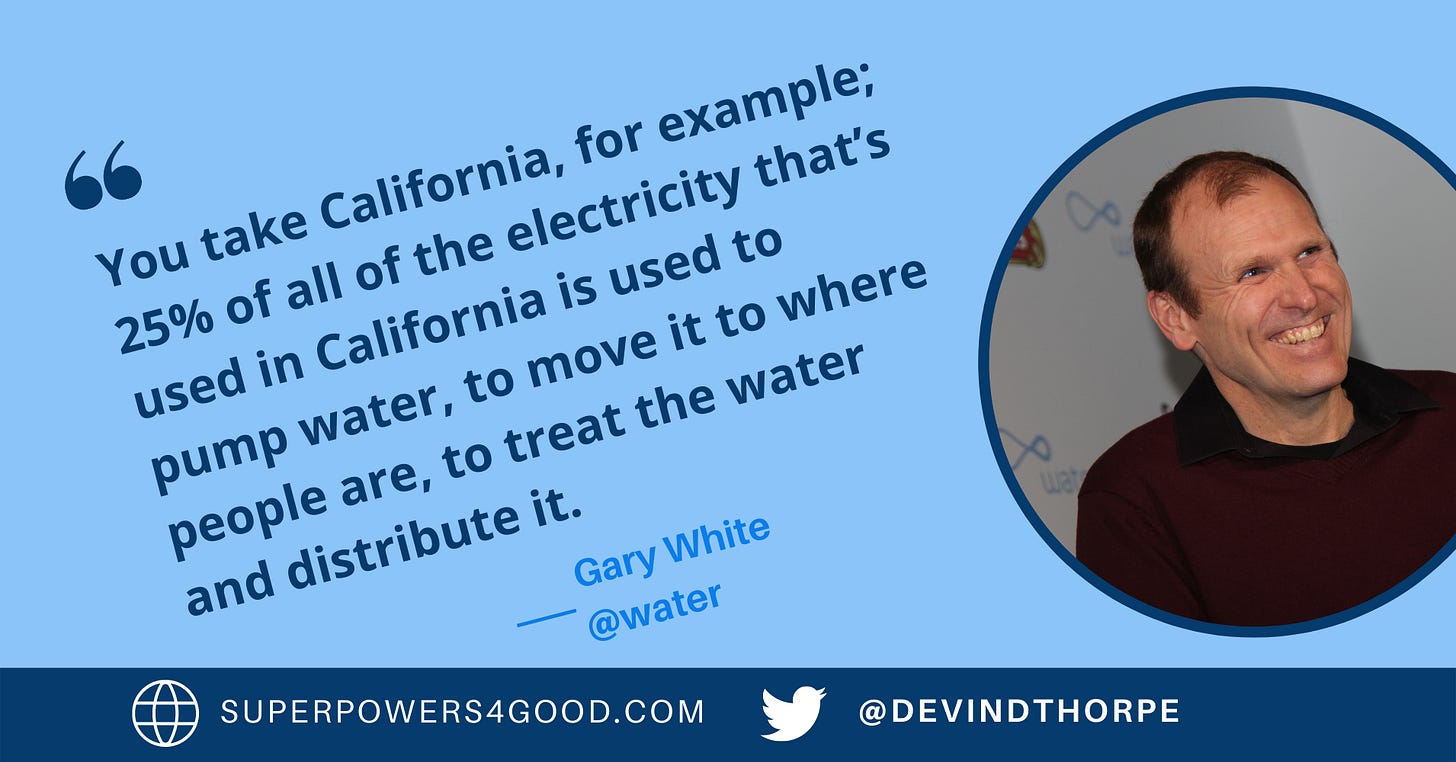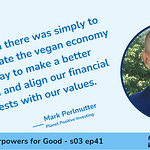Gary: I think if I can be permitted to talk about what might be another superpower, is that what I’ve discovered over the years is it’s about channeling.
Gary White has been among the most frequent guests on my show. He’s one of the most down-to-earth guys I know. With his Water.org partner and co-author megastar Matt Damon, Gary is accelerating water and sanitation access with impact investments.
Matt Damon Is Not Just Reading Lines
Gary is a big deal. Before partnering with Matt, he was already leading a nonprofit called Water Partners and was invited to the 2008 Clinton Global Initiative to speak. So, I was reluctant to ask Gary about Matt.
I first connected with Gary at Sundance at a Water.org event hosted by long-time supporter Stella Artois almost a decade ago. Matt was expected but didn’t show. A year later, Matt appeared at the reprised event and spoke to a crowd of reporters and influencers. I began to appreciate that Matt was serious about water.
Finally, in this podcast, I asked Gary about Matt.
Gary and Matt share the story of joining forces in their outstanding new book, The Worth of Water. Already aware of one another as each led a water-focused nonprofit, the meeting was strategic. Matt’s H2O Africa got him an invitation to CGI in 2008 as well. Conference organizers helped arrange the meeting.
Matt and Gary attended CGI the following year and announced the merger of the two organizations and the formation of Water.org.
“Matt has completely leaned into it,” Gary says. “We do some things in collaboration with [Stella Artois], and then he donates all of his fees from that back to Water.org.”
Gary illustrated Matt’s level of expertise and enthusiasm for the work with this story:
To give you an example of Matt as a business partner, it was during a field visit in India probably seven years ago where we were talking to our partners who offer these microloans for water sanitation improvements.
What is slowing you down, what could allow you guys to make even more of these loans and scale faster?
And every one of those financial institutions said we need more consistent access to affordable capital.
And so we're in the jeep digesting all these meetings that we had. It's like, well, we should be able to tap into people in the US and Europe who want to invest in things like this and get a financial return, even if it's modest.
And that was like the brainstorm and Matt's like, “Let's do this. I'll be the first investor.”
Not only does he see, like, the strategic importance of doing a spin-off like WaterEquity, but he'll put his own skin in the game to back it as any good entrepreneur would.
That's what it's like to work with Matt on these issues.
Using Impact Investing to Accelerate Water Access
It took a while for Gary to see the potential for charging people for water. The idea almost seems repugnant. To raise money from rich people to make loans to people to buy water access or toilets seems mercenary.
Gary shared the story of his “aha moment”:
This woman I met in India, for instance—this is what was my aha moment. She had taken out a loan from a loan shark in order to build a toilet. This woman was probably in her seventies or eighties, and she was poor, but she still wanted that toilet so bad because she was too old to climb down this rocky hillside to go to the railroad tracks in the middle of the night to relieve herself. Right. And so this is what she invested in.
She went to a loan shark and took out a loan for 125% interest on that loan. She didn't realize that necessarily, but she knew how much she was paying. I did the math and it's just like, oh, my gosh, this woman! And her experience is what is informing how we design water credit and how we see the potential for that to work.
The fundamental fact often lost on water philanthropists is that most low-income people already pay for water and sanitation, sometimes as much as 25 percent of their income.
Furthermore, the need is vast. The total cost of getting water and sanitation to all who need it is in the trillions of dollars. Gary and Matt saw that charging people low-interest rates on small loans that allowed them to save time and money would let Water.org help many more people.
Gary and Matt used Water.org to set up an affiliated money management firm, WaterEquity, that gathers impact investments and loans them to microlender partners who, in turn, make loans to people like the woman Gary met in India.
The repayment rate is 99 percent. WaterEquity funds target market rates of return to the investors, like Matt, who fund WaterEquity.
The success of WaterEquity requires Water.org to use a venture philanthropy approach. By using charitable funds to reduce the risk and operating cost of microloan programs, interest rates charged to customers can be lower and still yield a modest return to investors.
“We’ve raised about $250 Million in philanthropy over the course of Water.org that’s now unleashed $3.5 billion in microloans that have gone out into the world,” Gary says. “So, you can see the leverage that venture philanthropy can get you with the capital markets.”
Climate Change and Water Access
Only water nerds like Gary and Matt appreciate how climate change and water are inextricably interrelated.
“You take California, for example; 25% of all of the electricity that’s used in California is used to pump water, to move it to where people are, to treat the water and distribute it,” Gary says.
That energy has a huge carbon footprint, even with California’s growing reliance on renewable energy. Of course, the numbers are different around the world, but water distribution is inherently expensive in terms of both money and carbon.
“Across the emerging markets, it’s not atypical for a water system to lose 50 percent of the water that gets put into it because of antiquated infrastructure, broken pipes, poor billing, etc.,” Gary says. “So then you say, oh my gosh, this carbon footprint is massive.”
Gary and Matt and working now on how they can provide affordable loans to water utilities in the developing world to reduce water loss and energy waste.
But that’s only half the problem. Climate change is also threatening water supplies. Water.org will increasingly focus on climate adaptation strategies and mitigation efforts to ensure that people who have access to clean water now don’t lose it.
How to Make Channeling the Focus on Those You Serve As a Superpower
Gary was featured in my book Superpowers for Good for his superpower, tenacity.
In writing the book about these issues, Gary discovered a new superpower he calls “channeling.” He’s talking about keeping the focus on the people Water.org serves. “What we try to do in The Worth of Water, the book, is to just be narrators of their stories.”
To illustrate the art of channeling, Gary shared a story:
Just one story of those heroics that I would like to pass on and channel is a woman I met in Uganda a few years ago.
She introduced herself as Mama Florence. That was the name she gave me. She's a grandmother, actually, and she would spend hours every day on her bicycle searching for water for her children and some of her grandchildren.
She took out a loan of about $275 from one of our partners. And she installed a pump at her home and a water storage tank. And she now is using that water, obviously, to improve the health of her family.
But she also was growing a garden with the water and using the vegetables for better nutrition. Some of those she was feeding to pigs that she was now raising and selling. And then she started making bricks from the clay soil around her because she had water now to do that with. And so she was selling the bricks and then she built some small rooms near her house so that she could then rent those out.
Now she has water. Plus she has this incredibly unleashed entrepreneurial spirit that is allowing her to pay for her grandchildren to go to school. So this is like “why water,” right?
It's not just the downside, but it's the upside potential. And we don't realize how much it unleashed all of this global economic engine that we are. But it did. No city ever started or grew up without having access to water, and no family can realize their potential until they have access to water.
Channeling certainly includes the ability to tell stories like this, a skill Gary learns from Matt, which he acknowledges in the book. It is more than that, I think. It isn’t just about seeing the people you serve and helping others see them; it is also about keeping the focus on them.
From reading the book, it is clear that Matt is self-aware enough to recognize the outsized role plays in this work because of his global celebrity. He repeatedly brings the focus of his stories in The Worth of Water to the people they serve.
Matt and Gary use this technique not only to keep donors and readers focused on the people benefitting from their work but also to keep themselves grounded.
By following their example, you can make channeling the focus on those you serve a superpower that will allow you to do more good.














